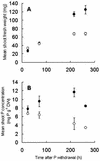Changes in gene expression in Arabidopsis shoots during phosphate starvation and the potential for developing smart plants
- PMID: 12805589
- PMCID: PMC166999
- DOI: 10.1104/pp.103.020941
Changes in gene expression in Arabidopsis shoots during phosphate starvation and the potential for developing smart plants
Abstract
Our aim was to generate and prove the concept of "smart" plants to monitor plant phosphorus (P) status in Arabidopsis. Smart plants can be genetically engineered by transformation with a construct containing the promoter of a gene up-regulated specifically by P starvation in an accessible tissue upstream of a marker gene such as beta-glucuronidase (GUS). First, using microarrays, we identified genes whose expression changed more than 2.5-fold in shoots of plants growing hydroponically when P, but not N or K, was withheld from the nutrient solution. The transient changes in gene expression occurring immediately (4 h) after P withdrawal were highly variable, and many nonspecific, shock-induced genes were up-regulated during this period. However, two common putative cis-regulatory elements (a PHO-like element and a TATA box-like element) were present significantly more often in the promoters of genes whose expression increased 4 h after the withdrawal of P compared with their general occurrence in the promoters of all genes represented on the microarray. Surprisingly, the expression of only four genes differed between shoots of P-starved and -replete plants 28 h after P was withdrawn. This lull in differential gene expression preceded the differential expression of a new group of 61 genes 100 h after withdrawing P. A literature survey indicated that the expression of many of these "late" genes responded specifically to P starvation. Shoots had reduced P after 100 h, but growth was unaffected. The expression of SQD1, a gene involved in the synthesis of sulfolipids, responded specifically to P starvation and was increased 100 h after withdrawing P. Leaves of Arabidopsis bearing a SQD1::GUS construct showed increased GUS activity after P withdrawal, which was detectable before P starvation limited growth. Hence, smart plants can monitor plant P status. Transferring this technology to crops would allow precision management of P fertilization, thereby maintaining yields while reducing costs, conserving natural resources, and preventing pollution.
Figures




References
-
- Abel S, Nguyen MD, Theologis A (1995) The PS-IAA4/5-like family of early auxin-inducible mRNAs in Arabidopsis thaliana. J Mol Biol 251: 533–549 - PubMed
-
- Abel S, Ticconi CC, Delatorre CA (2002) Phosphate sensing in higher plants. Physiol Plant 115: 1–8 - PubMed
-
- Baligar VC, Fageria NK, He ZL (2001) Nutrient use efficiency in plants. Commun Soil Sci Plant Anal 32: 921–950
-
- Bariola PA, Howard CJ, Taylor CB, Verburg MT, Jaglan VD, Green PJ (1994) The Arabidopsis ribonuclease gene RNS1 is tightly controlled in response to phosphate limitation. Plant J 6: 673–685 - PubMed
Publication types
MeSH terms
Substances
LinkOut - more resources
Full Text Sources
Other Literature Sources
Molecular Biology Databases

